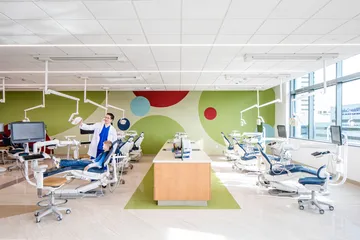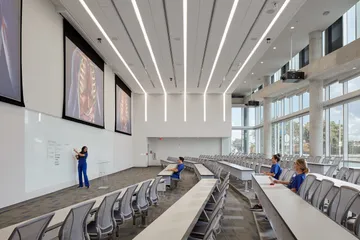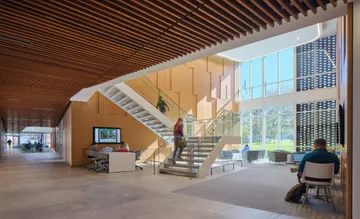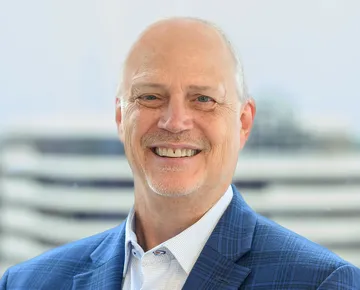Design Perspectives: Health Science Education

Meet Michael Ufer, AIA, our Academic Health Sciences Market Leader and Principal with Kahler Slater. With a passion for all things design, Michael specializes in designing environments that promote interdisciplinary collaboration, discovery, and learning. Michael is known to be a champion for his clients’ visions to ensure we deliver ideal adaptive environments where the curiosity of learning is explored and students thrive.
What drives your passion for designing health sciences education spaces?
The ability to make a difference through architecture has been a driver throughout my career. Design for health science education is an opportunity to support our future health and well-being. As we nurture the next generation of leaders and caregivers, you never know where the spark of innovation will come. I am passionate about creating spaces where students feel unencumbered, educational environments that celebrate them and give them what they need to learn critical skills as they dream, explore, and discover.

How is the movement for more holistic healthcare delivery impacting how we design health sciences education?
Students need realistic settings and practical applications to better understand how the healthcare experience can impact a patient’s physical, emotional, social, and spiritual needs. Thoughtfully designed spaces, such as simulation labs, immerse them in a patient-oriented healthcare setting. Pairing mock-up spaces, such as a hospital room, with adjacent observation areas and classrooms facilitates collaborative learning. Whether hands-on or in close observation, the learning experience is enhanced through multiple perspectives of a situation or procedure. The more realistic the simulated setting, the greater their perspective and the deeper their understanding of a patient’s needs. If providing the square footage needed to simulate an environment poses a challenge, technology offers viable solutions to achieve an effective practicum setting.

What exciting things are you seeing on campuses?
Campus leaders recognize they need to adapt their physical environment to attract and retain students and educators. The demographics and habits of students are evolving because they are more informed, and they want an experience that offers a sense of place and matches their desired learning methodology. This evolution means understanding the need for choice and flexibility in the campus setting to accommodate the different ways students learn, process information, and interact. As such, it makes design an exciting tool to reinvigorate learning for students and faculty. From public areas to see and be seen and hyper-personal spaces for study and reflection to collaborative classroom settings and specialty labs, each environment needs to foster meaningful experiences—spaces and places to learn, explore, and thrive.

How can design encourage inclusion and interprofessional collaboration?
It begins with a collaborative design process. Listening and understanding the needs, wants and aspirations of the different user groups and project stakeholders reveals how architectural details, space planning strategies, wayfinding and branding can create an inspired educational setting. From achieving a memorable sense of arrival to enticing people through a building through points of transparency or eye-catching details, design has the power to instill curiosity and create places that encourage spontaneous interactions and meaningful conversations. As we contemplate spatial relationships and paths of travel or create inviting communal areas, we lay the groundwork for inclusion and collaboration. The right spaces and design details improve access to invite all people and encourage conversations, debate, and the lively exchange of ideas and information.
Interested in learning more about how we are designing the future of Health Science Education? Connect with Michael on LinkedIn or via email.

Michael Ufer, AIA LEED AP
Principal, Practice Leader
As Principal and Academic Health Sciences Practice Leader, Michael is passionate about leveraging design to evolve and enhance a student’s experience as they train to become the next generation of healthcare providers. He specializes in designing environments that promote interdisciplinary collaboration, discovery, and learning. Michael is known to be a champion for his clients’ visions to ensure we deliver ideal adaptive environments where the curiosity of learning is explored and students thrive.